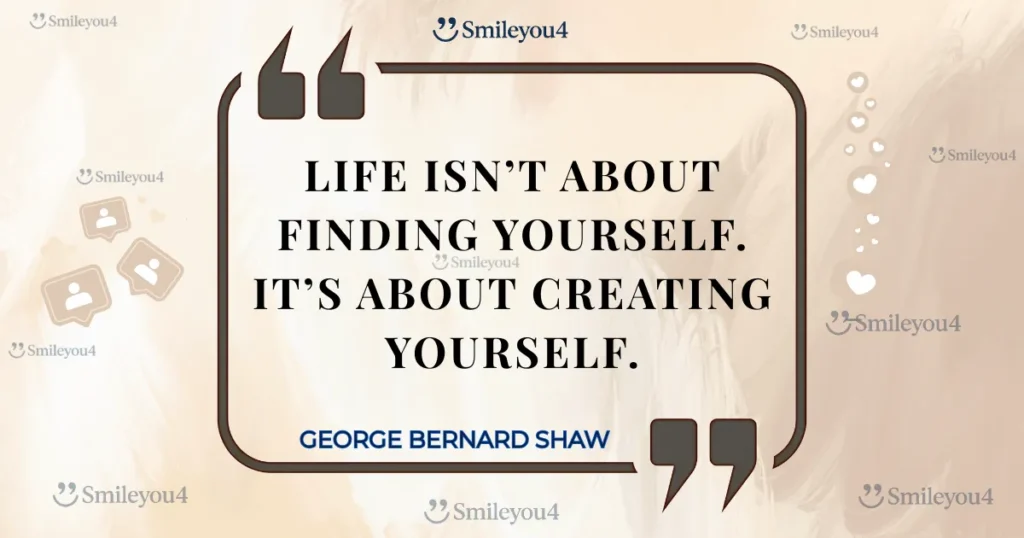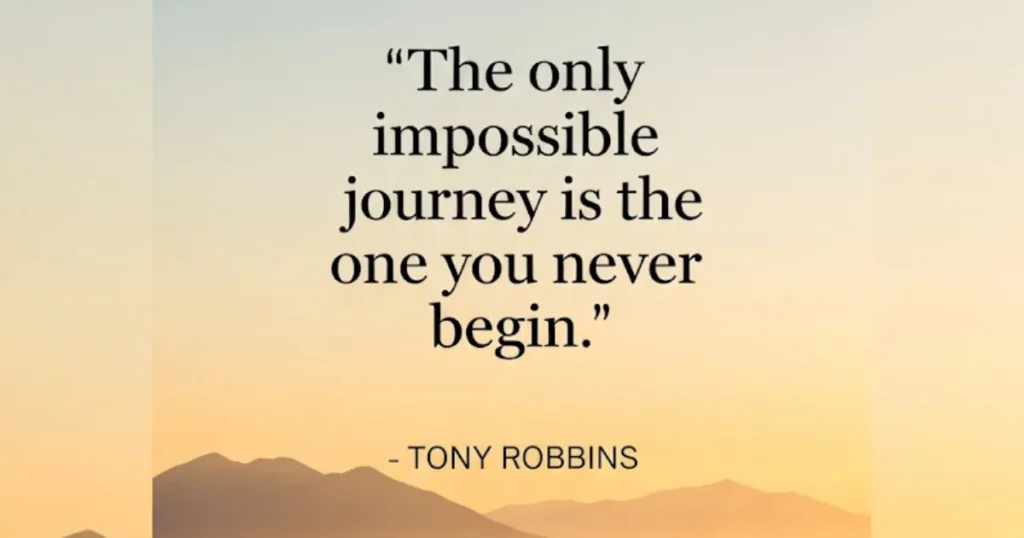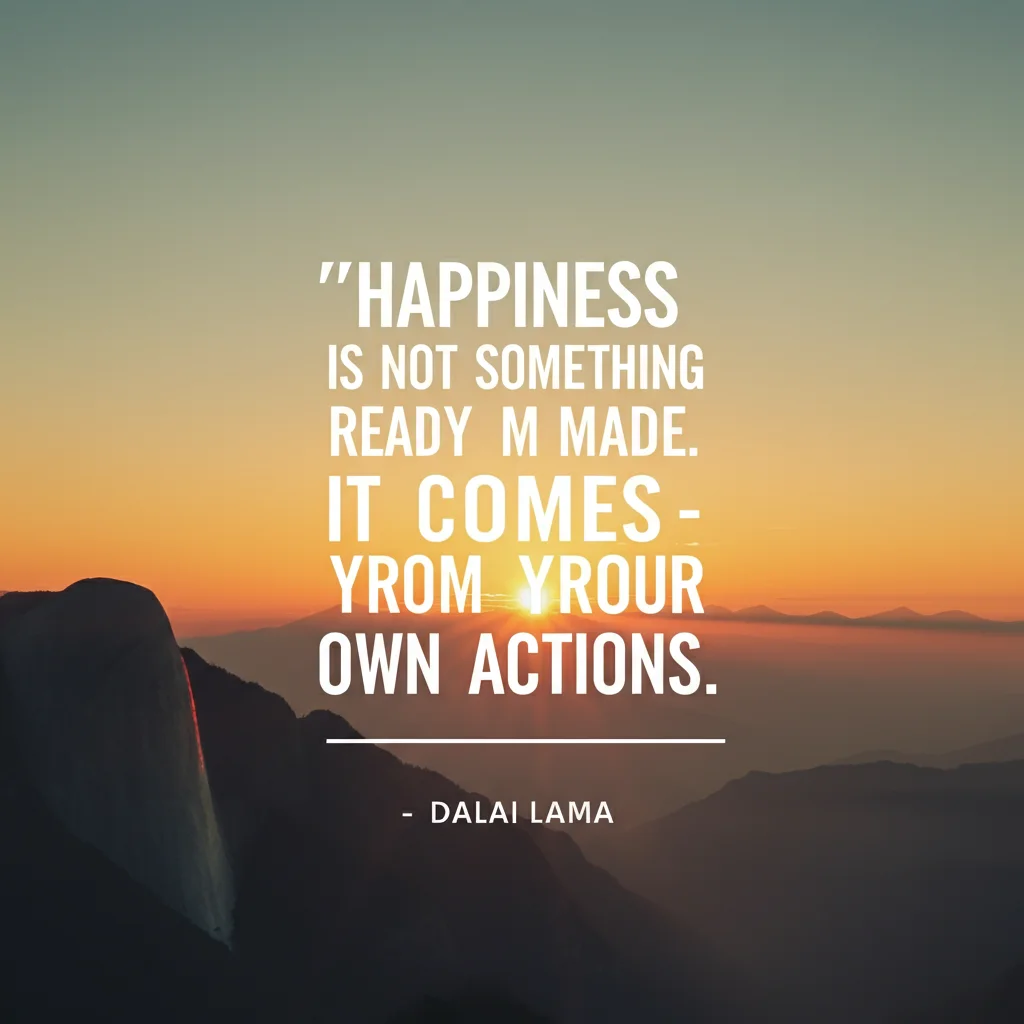What if you’ve been approaching life all wrong? What if instead of wandering through the world trying to discover who you are, you could actively design and build the person you want to become? Irish playwright George Bernard Shaw understood something revolutionary when he said, “Life isn’t about finding yourself. It’s about creating yourself.” This profound insight from George Bernard Shaw isn’t just clever wordplay—it’s your blueprint for taking control of your destiny and becoming the architect of your own character.

You’ve probably heard countless people say they’re “trying to find themselves.” Maybe you’ve said it too. But here’s what Shaw discovered through his remarkable life: waiting to stumble upon your true self is like waiting for lightning to strike. The most fulfilled people don’t find themselves by accident—they create themselves on purpose.
Today, you’ll discover how to shift from passive self-discovery to active self-creation. We’ll explore practical ways to design your character, build your skills, and craft the life you truly want. Get ready to stop searching and start building.
The Playwright Who Rewrote the Rules of Living
George Bernard Shaw’s Revolutionary Approach to Self-Development
When George Bernard Shaw declared that life is about creating yourself, he spoke from the experience of someone who had done exactly that. Born into modest circumstances in Dublin, Shaw didn’t accept the limitations others expected from him. Instead, he consciously crafted himself into one of the most influential writers and thinkers of his time.
Shaw transformed himself from a shy, unsuccessful young man into a confident playwright, critic, and social activist. He didn’t wait to “find” his calling—he created it. He developed his writing skills through deliberate practice, shaped his opinions through extensive reading, and built his confidence by forcing himself to speak publicly despite his natural shyness.
This George Bernard Shaw creating yourself philosophy emerged from someone who proved that you don’t have to be born with extraordinary gifts to achieve extraordinary things. You just need the courage to take responsibility for designing who you become.
Why This Quote Changes Your Entire Life Approach
“Life isn’t about finding yourself. It’s about creating yourself.” These nine words hold the power to revolutionize how you approach every aspect of your existence:
- “Life isn’t about finding yourself” frees you from the myth that your true self is hidden somewhere waiting to be discovered
- “It’s about creating yourself” empowers you to take active control over who you become
- The complete message transforms you from a seeker into a creator
This philosophy works because it puts you in the driver’s seat of your own development. Instead of hoping to stumble upon your purpose, you start building it deliberately, one choice at a time.
The Science Behind Self-Creation and Personal Growth
How Your Brain Responds to Intentional Change
Modern neuroscience confirms what Shaw intuitively understood about human potential. Research shows that your brain remains remarkably plastic throughout your life, constantly forming new neural pathways based on your thoughts, actions, and experiences.
Mental benefits of self-creation include:
- Enhanced sense of personal agency and control over your life direction
- Increased confidence as you prove to yourself that change is possible
- Greater resilience when you see challenges as opportunities for growth
- Improved self-esteem from actively building skills and character traits
The neuroplasticity advantage:
When you embrace creating yourself, you’re working with your brain’s natural ability to rewire itself. Every new skill you learn, every positive habit you develop, and every courageous action you take literally changes your brain structure.
Studies reveal that people who actively work on self-improvement show measurable changes in brain regions associated with:
- Executive function and decision-making
- Emotional regulation and stress management
- Learning and memory formation
- Creative problem-solving abilities
This scientific backing proves that George Bernard Shaw’s wisdom about creating yourself isn’t just inspirational—it’s backed by decades of neuroscience research.
Modern Champions of Self-Creation
Oprah Winfrey: From Poverty to Purpose Through Intentional Growth
Oprah perfectly embodies Shaw’s philosophy that life is about creating yourself. Born into poverty and facing numerous challenges, she didn’t wait for circumstances to change—she changed herself. Through deliberate effort, continuous learning, and conscious character development, she created herself into a media mogul and inspirational leader.
Her self-creation journey included:
- Developing her communication skills through practice and study
- Cultivating empathy and emotional intelligence through personal work
- Building business acumen by learning from mentors and taking risks
- Creating her unique brand by staying authentic while continuously growing
Oprah shows us that when you understand George Bernard Shaw creating yourself wisdom, your starting point doesn’t determine your destination—your daily choices do.
Steve Jobs: Designing Himself Into an Innovation Icon
Steve Jobs exemplified the art of self-creation throughout his career. He didn’t just accept the role of a college dropout with limited options. Instead, he consciously crafted himself into a visionary leader who changed multiple industries.
His approach to creating yourself demonstrated:
- Learning design principles by studying calligraphy and art
- Developing his presentation skills until they became legendary
- Building his business instincts through trial, error, and persistence
- Cultivating his unique leadership style by studying what worked and what didn’t
Jobs proved that you don’t need formal credentials to create extraordinary results—you need commitment to creating the person capable of achieving your vision.
Michelle Obama: Building Herself Into a Role Model
Michelle Obama’s transformation from a working-class Chicago kid to First Lady and bestselling author showcases the power of intentional self-development. She didn’t stumble into success—she created it through conscious choices about education, character, and service.
Her self-creation strategy included:
- Prioritizing education as a tool for transformation
- Developing her voice and confidence through public speaking
- Building leadership skills in every role she accepted
- Creating her platform to inspire others while staying true to her values
Obama demonstrates that creating yourself isn’t about becoming someone else—it’s about becoming the best version of who you can be.
Practical Steps to Start Creating Yourself Today
Design Your Future Self Vision
The first step in creating yourself is getting clear about who you want to become. This isn’t about picking a career—it’s about designing your character, values, and the impact you want to have.
Vision creation exercises:
- Write a detailed description of yourself five years from now: What skills do you have? How do you spend your days? What kind of person have you become?
- Identify three character traits you want to develop and specific ways to practice them
- List five skills that would transform your potential and create learning plans for each
- Ask yourself: “If I could design myself from scratch, what would I build?”
Daily vision alignment:
- Each morning, ask yourself: “What would my future self do today?”
- Make one choice daily that moves you closer to your vision
- End each day by reflecting on how your actions matched your creation goals
- Celebrate small progress toward becoming who you’re designing
Build Your Character Through Daily Choices
George Bernard Shaw understood that character isn’t fixed—it’s created through consistent choices over time. Every decision you make is an opportunity to create yourself.
Character creation strategies:
- Choose one virtue to focus on each month (courage, kindness, integrity, persistence)
- Practice that virtue in small ways throughout each day
- Notice situations where you can choose growth over comfort
- Ask friends to hold you accountable for the character traits you’re building
Skill development system:
- Identify three skills that would transform your potential
- Dedicate 30 minutes daily to deliberate practice in one area
- Find mentors or courses that accelerate your learning
- Track your progress to maintain motivation and momentum
Create Your Personal Growth Laboratory
Transform your life into an experiment in creating yourself. Use every experience as data about what works and what doesn’t in building the person you want to become.
Weekly self-creation review:
- What new things did I try this week?
- Which actions moved me closer to my vision?
- What patterns am I noticing in my thoughts and behaviors?
- How can I adjust my approach to create better results?
Monthly growth challenges:
- Set a specific skill-building goal for each month
- Try something completely outside your comfort zone
- Seek feedback from people you trust about your progress
- Document lessons learned and apply them going forward
Overcoming Common Obstacles to Self-Creation
Moving Beyond “This Is Just Who I Am” Thinking
Many people resist creating yourself because they believe personality and abilities are fixed. This limiting belief keeps them trapped in patterns that don’t serve their potential.
Growth mindset shifts:
- Replace “I’m not good at this” with “I’m not good at this yet”
- View challenges as opportunities to create new capabilities
- See failures as data about what to adjust, not proof of your limits
- Remember that George Bernard Shaw created his talents through practice, not luck
Evidence gathering for change:
- Keep a journal of skills you’ve developed and improvements you’ve made
- Notice examples of people who transformed themselves dramatically
- Celebrate small changes as proof that bigger transformations are possible
- Focus on your growth rather than comparing yourself to others
Dealing with External Resistance
When you commit to creating yourself, you might face resistance from people who prefer you to stay the same. This is normal and doesn’t mean you should abandon your growth.
Handling others’ reactions:
- Remember that your growth might trigger others’ insecurities about their own stagnation
- Surround yourself with people who support your development
- Don’t ask permission to become the person you want to be
- Use criticism as motivation to prove your commitment to change
Your Daily Self-Creation Practice
Morning Intention Setting
Start each day by consciously choosing who you want to be and how you want to show up in the world.
Morning self-creation ritual:
- Before checking your phone, ask: “Who am I creating today?”
- Choose three ways you’ll practice becoming your future self
- Set an intention to notice opportunities for growth throughout the day
- Visualize yourself successfully embodying the traits you’re building
Evening Progress Review
End each day by reflecting on your self-creation efforts and planning tomorrow’s growth.
Evening reflection questions:
- How did I create myself today through my choices and actions?
- What opportunities for growth did I take, and which did I miss?
- What did I learn about myself and what I’m capable of?
- How will I continue creating yourself tomorrow?
Your Self-Creation Action Plan
Now that you understand George Bernard Shaw’s revolutionary approach to life, it’s time to stop searching and start building. Remember, you don’t find yourself by waiting—you create yourself by acting.
Your next steps:
- Choose one character trait you want to develop and practice


